Unit 9: Global Change
{{9.1-9.2 Stratospheric Ozone Depletion{{
^^Good Ozone^^
- The protective layer in the stratosphere
^^Bad Ozone^^
- “Ground-level”; photochemical oxidant (sunlight reacts with SO2 and NOs)
^^The function of the Ozone Layer^^
- Absorbs the sun’s UV Rays, allowing just enough for life on earth
^^Formation of the Ozone Layer^^
- Step 1 of Ozone Formation: O2 + UV-C → O + O
- Step 2 of Ozone Formation: O +O2 → O3
^^What are CFCs:^^
- Chlorofluorocarbons
- Nontoxic, nonflammable, very stable
- Contains C, CL, and F
- Found in refrigerants, propellants (aerosols), foam, and packing materials
- So Cl acts as a catalyst—it aids another reaction but is not getting used up itself
- 1 Cl atom can break down 100,000 ozone molecules before it bonds with another Cl atom, creating Cl2 and stopping the reaction
^^How do CFCs break down ozone?^^
UV causes a chlorine atom to break away from the CFC molecule
The free chlorine atom hits an ozone molecule
The chlorine atom pulls one oxygen atom away.
A free oxygen atom hits the chlorine monoxide molecule
The result is another free chlorine atom
Free chlorine will continue to deplete ozone in the stratosphere
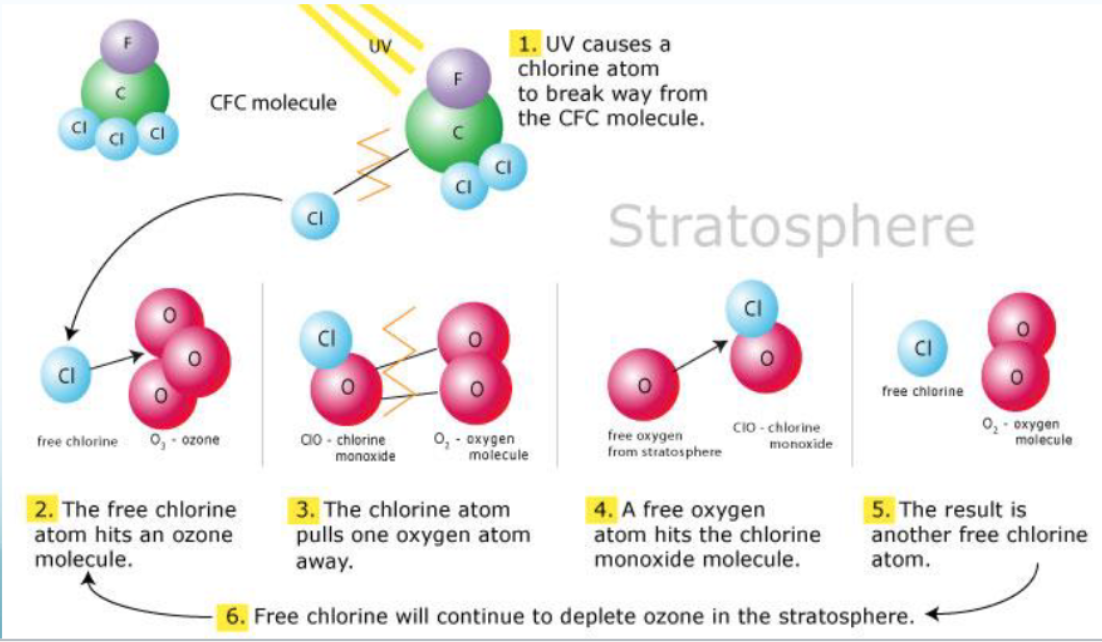
^^International Action- The Montreal Protocol^^
- Montreal Protocol: Gradually eliminating the production and consumption of ozone-depleting substances to limit their damage to the earth’s ozone layer.
- Considered to be the most successful environmental global action.
^^Reversing Stratospheric Ozone Depletion^^
- Stop producing ozone-depleting chemicals immediately
- It will take at least 60 years to 1980 levels
- Agreements with a prevention approach
- Montreal protocol: Cut emissions of CFCs
- Copenhagen Amendment: Accelerated phase-out of CFCs
^^Natural Capital Degradation→Effects of Ozone Depletion^^
- Human Health and Structure
- Worse sunburns
- More eye cataracts and skin cancers
- Immune system suppression
- Food and Forests
- Reduced yields for some crops
- Reduced seafood supplies due to smaller phytoplankton populations
- Decreased forest productivity for UV-sensitive tree species
- Wildlife
- More eye cataracts in some species
- A shrinking population of aquatic species sensitive to UV radiation
- Disruption of aquatic food webs due to shrinking phytoplankton populations
- Air Pollution and Climate Change
- Increased acid deposition
- Increased photochemical smog
- Degradation of outdoor painted surfaces, plastics, and building materials
- While in the troposphere, CFCs act as greenhouse gases
{{9.3 The Greenhouse Effect{{
Core Case Study: Melting Ice in Greenland
- World’s largest island: Mostly covered by ice glaciers
- Glaciers melting at an accelerating rate in summers
- Atmospheric warming is a crucial factor
- Greenland’s ice loss: Responsible for nearly one-sixth of the global sea-level rise over the past 20 years
^^How and Why Is the Earth’s Climate Changing?^^
- Scientific evidence strongly indicates that the earth’s atmosphere is warming at a rate that is likely to lead to significant climate change
- Weather: Short-term changes
- Climate: Average weather conditions of a particular area over 30 years or more
^^Climate and the Natural Greenhouse Effect^^
- The greenhouse effect is a natural process
- Heat-holding gases absorb heat
- CO2, CH4, N2O
- Historical changes in the amount of carbon dioxide in the atmosphere correlate to changes in global temperatures
^^Earth’s Greenhouse Effect^^
Incoming solar radiation: UV and visible light
1/3rd reflected back into space
The remaining light is absorbed by clouds and the planet’s surface
- These become warmer, emit infrared radiation
This radiation is either absorbed by the GHGs or emitted into space
More GHGs = more IR absorbed & emitted back to earth
This process should be in equilibrium; short term, inputs might be higher or lower, which causes global warming/cooling (ice ages)
- N2 and O2 = 99% of the atmosphere- NOT GHGs
H2O Vapor: Absorbs more IR than anything else, but does not persist
CO2
CH4 (methane)
H2O (nitrous oxide)
O3 (ozone)
CFCs (not natural)
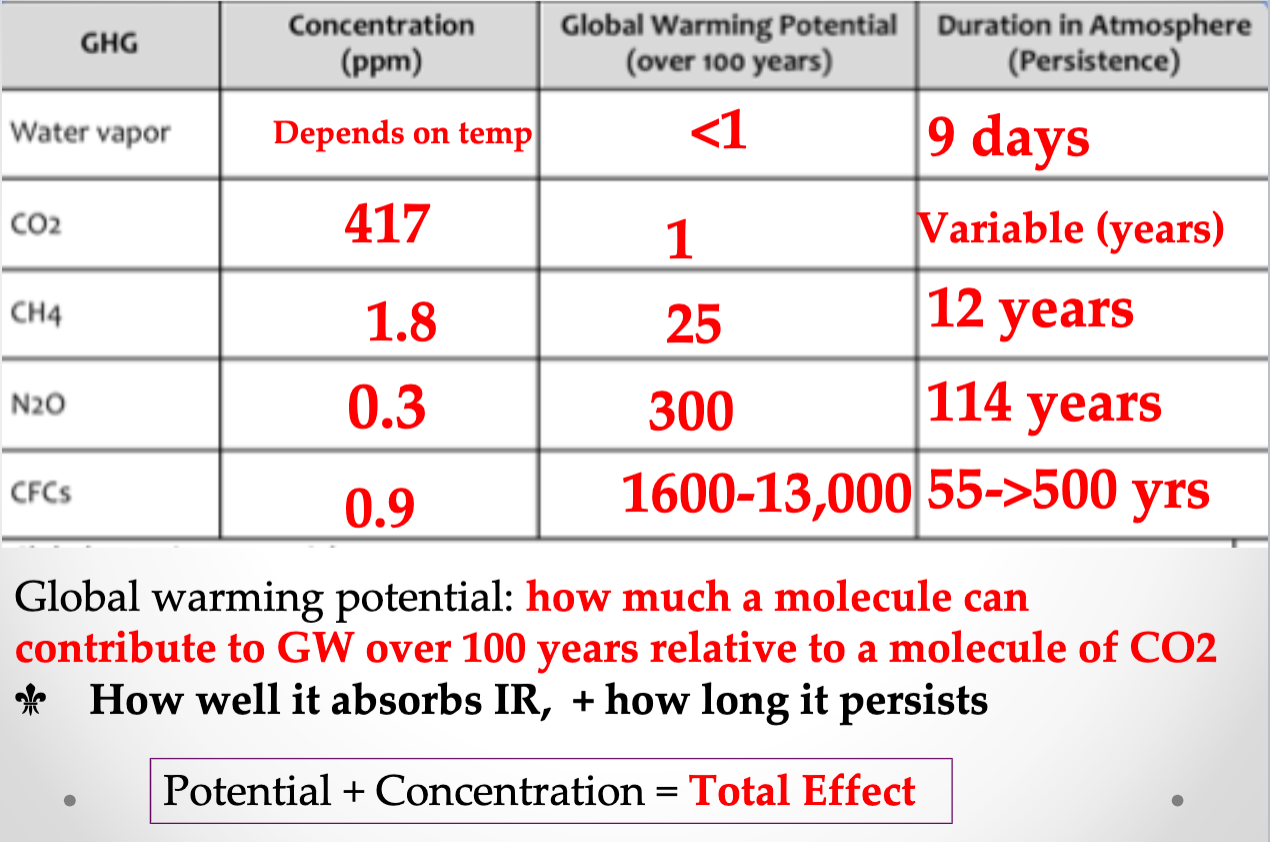
^^Natural Sources of GHGs^^
Volcanoes: ash reflects incoming radiation, so a cooling effect
Decomposition & Digestion: Dead organic matter is converted into CO2 unless there is not enough O2. If there is not enough O2, it’s converted to CH4 (methane)
- Methane sources
- Wetlands
- Termites
Denitrification: How we get N2O or nitrogen cycle

Evaporation and Evapotranspiration: water vapor
^^Anthropogenic Sources of GHGs^^
- Fossil Fuels: CO2, methane, N2O
- PM lowers albedo (black soot) causing a cooling effect
- Agriculture
- Overirrigation: low O2 so methane-like wetlands
- Fertilizers: identification so an increase in N2O
- Livestock: cattle and sheep create methane
- Deforestation: less photosynthesis, more CO2 burning releases PM, methane, N2O as well
- Landfills: Methane
- Modern chemicals like CFCs: HCFCs (have replaced CFCs) also GHGs
^^Threats to Human Health and the Environment^^
Thermal expansion of ocean water
Disease vectors spreading from the tropics to the poles
Rising sea levels
Population movements
Global climate change
Population dynamics
Excess GHGs in the atmosphere
Melting ice sheets
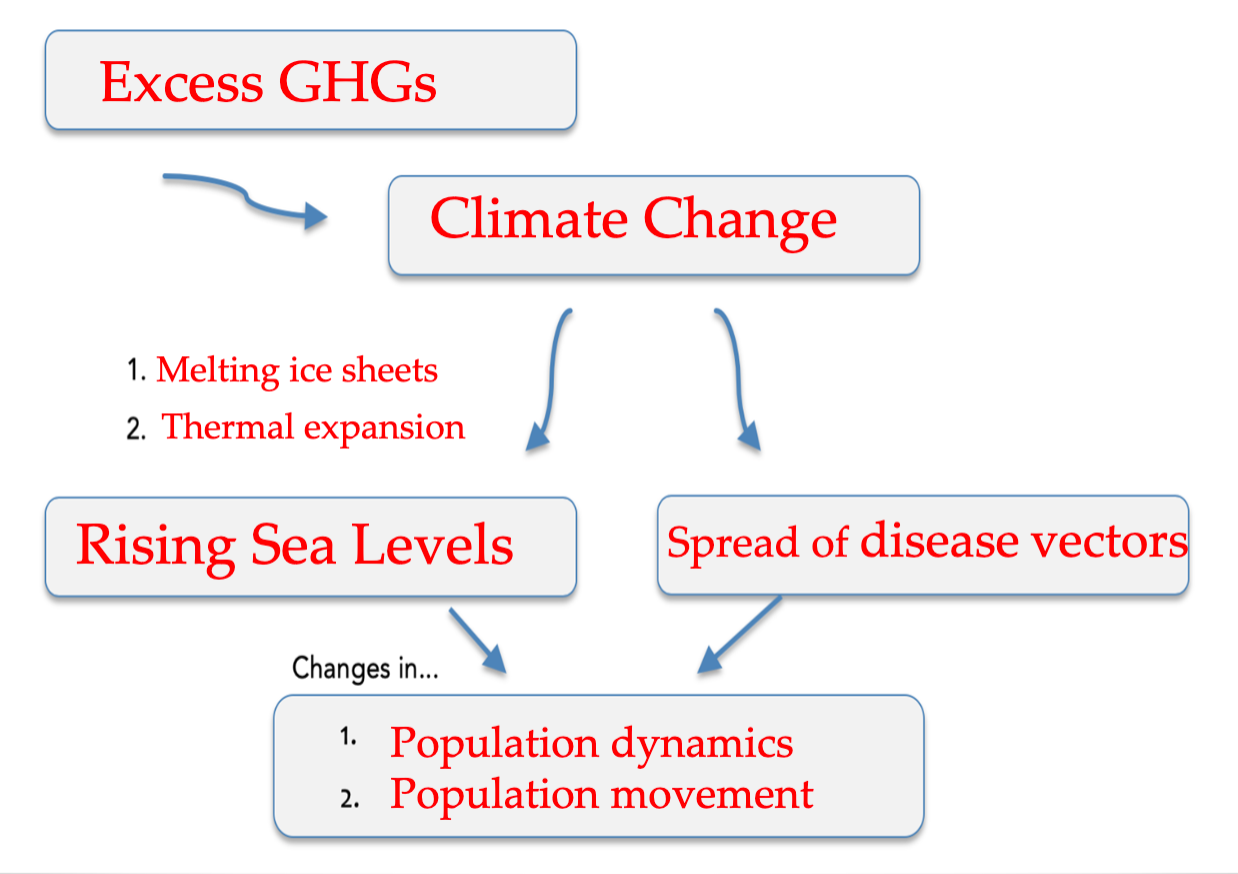
{{9.5-9.7 Global Climate Change{{
- Global change: Planetary scale changes in Earth systems land, air life, soil, atmosphere, oceans, humans
- Global climate Change: changes in temperature, precipitation, wind, storms, currents, etc.
- Global warming: Increase in average temp of earth over time
^^Causes^^
- Increasing CO2 concentration
- Keeling Cure: First to accurately measure CO2
- CO2 levels vary seasonally and increase overall
- Why is there a seasonal fluctuation?
- Vegetation, most of it is in the northern hemisphere so overall there is a huge decrease in our spring/summer
- Why is there a latitudinal difference?
- 90% of the world’s population is in the northern hemisphere
- 60% of the world’s land
- However, phytoplankton (single-celled algae) produce > 40% of the world’s oxygen
- Why does it increase overall?
- Increased emissions from fossil fuel combustion
- Net destruction of vegetation
- Temperature Increases: Global temperatures have increased on average 1.4F, but regionally up to 4F
- Changing species compositions
- Proxy data: Preserved physical characteristics of the environment that can stand in for direct measurement
- Foraminifera: different species prefer different temps; very narrow range
- Fossilize well
- Sedimentary layers of the ocean floor
- Ice cores
- Data from 500,000 years
- Air bubbles are trapped each year as layers of ice laid down
- Ice in warmer temps has more O-18 isotopes (heavy)
- For half a million years, CO2 has never been above 300 ppm; last 60 years has risen to >400 ppm
- Methane and N2O have also increased
- Tree rings
- Coral growth rings
- Pollen spores
- What caused CO2/Temp shifts before humans?
- Path of orbit/position relative to the sun
- Orbital tilt
^^Developing countries overtook developed in CO2 emissions^^
- Industrialization happens first→ through fossil fuel combustion in stage 2
- There is no money or political will to pass progressive environmental laws until phases III or IV
^^We use climate models to make predictions^^
- Air/ocean temperatures
- Concentrations of CO2, other GHGs
- Amount of vegetation/sea ice
^^Effects of Global Warming^^
Polar ice melting
- Sea level rise
- Polar bear habitat is lost
Glaciers melting
- Lack of water supply
Permafrost melting
- Lakes drain deeper into the ground, lose water
- Cause erosion with loss of structural support
- Organic matter decomposes and releases methane
Ocean acidification: CO2 dissolves in water to form H2CO3 (carbonic acid). Dissolves shells/skeletons of marine organisms (crustaceans, mollusks, coral)
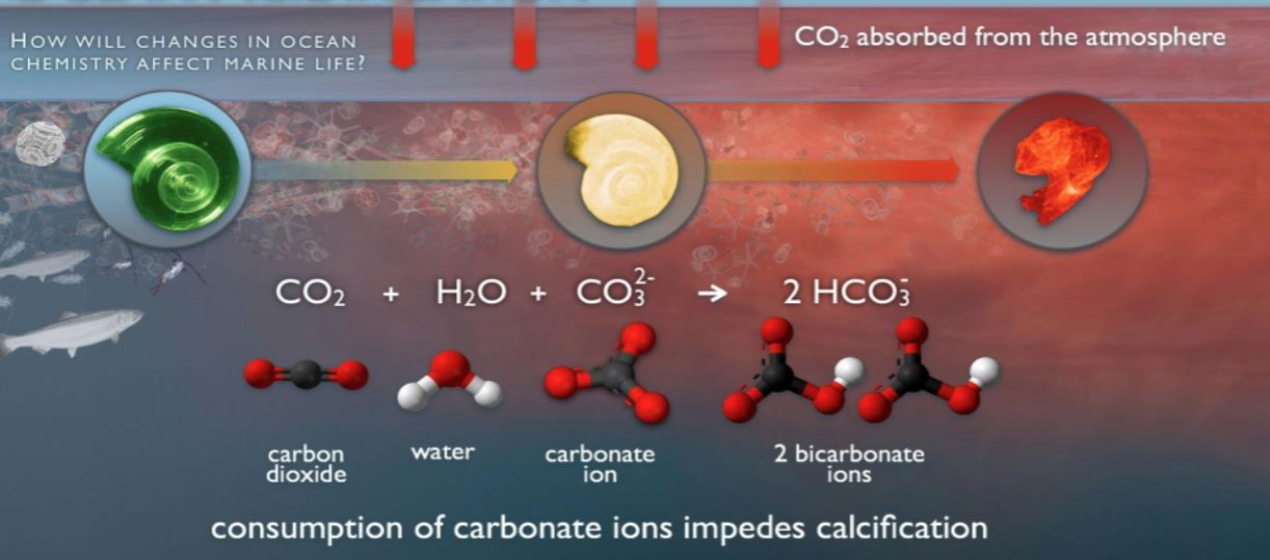
Sea level Rise
- Has risen by 9 in (2.2 cm)
- By 2100, 7-23 in. more
- Total volume increases as land ice melts
- Water expands as it gets warmer (thermal expansion)
- Effects→flooding of coastal nations and towns, saltwater intrusion into aquifers, increased erosion
- 100 million people live within 3 ft. of sea level
^^Effects on Organisms^^
- Ranges have shifted toward both poles
- Plants flower earlier, birds, migrate earlier, insects emerge earlier
- Coral bleaching: range of temperature tolerance is small
- Fragmentation prevents migration
^^Future Effects^^
- Heat waves
- Increased energy demand
- Risk of death to poor and elderly
- Damage to crops and increased irrigation needs
- Cold spells
- May have some positive effects
- Expands the range of pest species
- Precipitation Patterns
- Where there’s less, crops require more irrigation
- Where there’s more, there is flooding, landslides, erosion
- Storm Intensity
- Ocean warming causes more hurricanes
- Ocean currents
- Thermohaline circulation: freshwater dilutes the ocean and stops salt water from sinking near Greenland
^^Effects on Humans^^
- Relocation/Climate refugees
- Health→ heat waves, infectious diseases
- Tourism→ snow, coral reefs
^^Positive Effects of Climate Change^^
- Fewer deaths, crop damage due to cold
- New habitats become hospitable to humans
- Higher rainfall = recharge aquifers, more crops
^^1997: Kyoto Protocol^^
- Kyoto Protocol: Set goals for global emissions of GHGs to be reduced by 2012
- Different amounts required from different countries---US 7%
- Developing (China/India) had no limits
- The US would not ratify
^^Precautionary Principle^^
- Reduce emissions: Increase fuel efficiency, renewable energy
- Carbon sequestration: return agricultural lands to pasture/forest
- Capture CO2 from emissions and pump underground or into the ocean
{{9.8-9.9 Invasive and Endangered Species{{
^^Introduced Non-native Exotic^^
- Brought outside of historical range by humans
- does not necessarily have negative impacts
^^Invasive^^
- Has a negative impact on the ecosystem
- May spread rapidly
- Outcompete natives, disrupt food webs
- May have been introduced on purpose or accidentally
^^Illegal Trade^^
- Lacey Act (1900): (one of the earliest environmental laws) prohibits the transport of illegally harvested plants and animals
^^International treaty CITES (1973)^^
- Convention on International Trade in Endangered Species of Wild Fauna and Flora
- IUCN Red List: threatened species. In each country, an agency is assigned to monitor the import and export of species on the list. (US Fish & Wildlife)
- Illegal trade = $5-20 billion/yr
{{9.9 Endangered Species{{
^^Causes of Endangerment--Natural^^
- Starvation
- Excessive predation
- Loss of habitat through natural means
- Impediments to mating
- Natural disaster
- Being outcompeted by other similar species
^^Causes of Endangerment--Anthropogenic^^
- HIPPCO
- Habitat Destruction
- Degradation
- Fragmentation
- Invasive Species
- Pollution
- Population
- Climate Change
- Overexploitation
- Overhunting
- Overharvesting
- Overfishing
^^Selective Pressures^^
- Selective Pressures: Any factors that change the behaviors and fitness of organisms within an environment
- “Selective” = Natural selection = leads to evolution
- Not all species are equally impacted by selective pressures and ecosystem changes
- Adaptability
- Mobility
^^Protecting Endangered Species^^
Criminalizing poaching
Protecting animal habitats
- Factors influencing ecosystem conserve nation plans
- Size, shape, connectedness
- Theory of island biogeography
- Metapopulations: Spatially separated pops of the same species, interact and interbreed
- SLOSS (Single Large or Several Small)
- Edge habitat
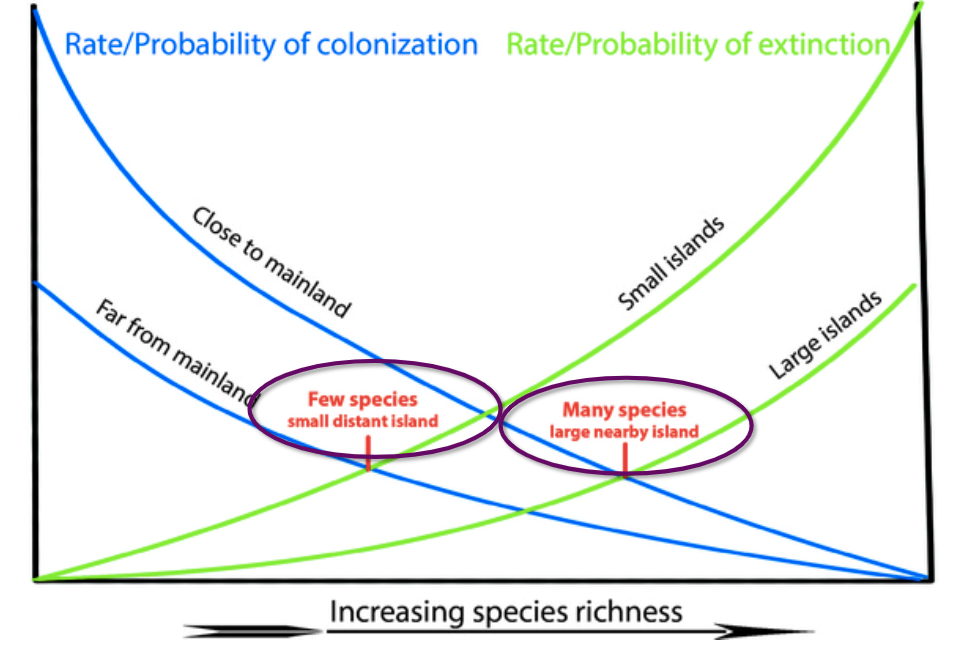
Biosphere reserves: contain zones that vary in the allowed amount of impact. The central core, buffer zone, transition area
Legislation
- Single species legislation
- More traditional option
- Become experts on important species
- Focus $/resources/efforts
^^Which species “deserve” this focused attention?^^
- Indicator: Quickly reflected changes in ecosystems functioning
- Keystone: Has a disproportionate, far-reaching impact on species in its ecosystem
- Flagship/Charismatic: Popular with humans due to their '“cuteness”, large size, and/or high intelligence. Serves to raise concern and awareness
- Umbrella: The conservation and protection of these species indirectly affect the conservation and protection of other species within their ecosystem
^^Limitations of the single-species approach^^
- Protecting HABITAT instead allows the ecosystem to be more flexible/natural
- Protects species/relationships we’re not even aware of
- Focus $/efforts on “hot spots” of biodiversity (rainforests, coral reefs)
^^Marine Mammal Protection Act (1972)^^
- Marine Mammal Protection Act (1972): Prohibits killing any marine mammals in the US and any import/export of MM body parts
^^Endangered Species Act (1973)^^
- Endangered Species Act (1973): Authorizes the USFWS to determine which species can be listed as threatened or endangered. Prohibits their harm as well as the trade of fur/other body parts
- Endangered: Danger of extinction within the foreseeable future
- Threatened: Likely to become endangered in foreseeable future throughout all or a significant portion of its range
^^Instrumental (Extrinsic) Value^^
- Goods and services
- Recreation
- Aesthetics
- Medicine/research
- Genetic info
^^Intrinsic Value^^
- Right to exist regardless of practical use to humans
- E.O Wilson
- Biophilia: inherent genetic kinship with the natural world
{{9.10 Human Impacts on Biodiversity{{
^^Why is our current estimate too low?^^
- Population growth, resource consumption, and climate change continue to increase
- The actual number of species is unknown
- Very expensive and difficult to accurately categorize all extant species
- New species are being discovered all the time
- Rates are even higher in the centers of highest biodiversity--a hotspot
- Terrestrial- rainforests
- Marine- coral reefs
- Potential habitats for new species are increasingly degraded and fragmented→speciation crisis
^^How does climate change impact habitat loss?^^
- Changes in temp and precipitation outside of species’ range of tolerance
- The sea level rising is destroying polar and coastal habitats